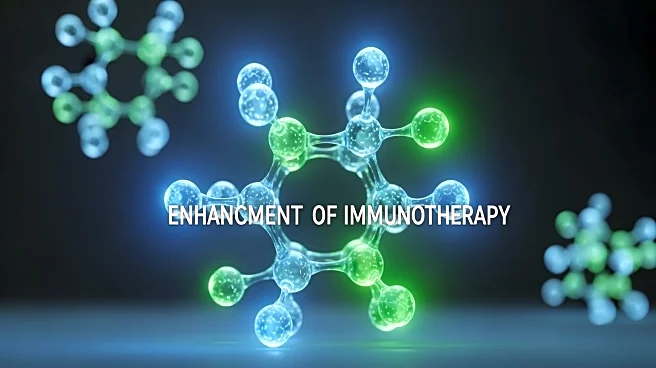What's Happening?
A research team has developed a novel system called PATCH (proximity amplification and tagging of cytotoxic haptens) that enhances the labeling of proteins in deep tissue environments. This system utilizes a porphyrin-zirconium catalyst incorporated into
nanoparticles, which can label proteins with biotin probes under red light or ultrasound. The innovation allows for spatial control of protein labeling with synthetic antigens, which are biocompatible but become immunogenic when linked to proteins. The team demonstrated the use of PATCH with bispecific T cell engagers (BiTEs) to promote TCR activation. By conjugating nanozymes with ligands or antibodies of target antigens such as HER2, folate receptor, and CD44v6, and activating them with red light or ultrasound, they achieved localized labeling around target antigens. This enabled BiTEs to bind fluorescein and TCRs, enhancing TCR clustering, activating T cells, and eradicating solid tumors in mice.
Why It's Important?
The development of the PATCH system represents a significant advancement in the field of immunotherapy. By enabling precise control over protein labeling in vivo, this technology could revolutionize how immune responses are manipulated in cancer treatment. The ability to target specific antigens and enhance T cell activation could lead to more effective therapies for solid tumors, which are often challenging to treat with conventional methods. This innovation could potentially improve patient outcomes and expand the range of treatable cancers. Furthermore, the application of this technology could extend beyond cancer, offering new strategies for controlling immune cell signaling in various diseases.
What's Next?
The next steps for this research involve further testing and refinement of the PATCH system to ensure its efficacy and safety in clinical settings. Researchers may explore additional applications of this technology in other areas of immunotherapy and immune cell signaling. Potential collaborations with pharmaceutical companies could accelerate the development of new treatments based on this technology. Regulatory approval processes will be crucial for translating this research into clinical practice, and ongoing studies will likely focus on optimizing the system for human use.
Beyond the Headlines
The PATCH system's ability to control protein labeling with synthetic antigens introduces new ethical and regulatory considerations. As this technology advances, it will be important to address potential risks associated with manipulating immune responses. Long-term studies will be necessary to understand the implications of using such targeted therapies on the immune system and overall health. Additionally, the cost and accessibility of these advanced treatments will be critical factors in determining their impact on healthcare systems and patient populations.













